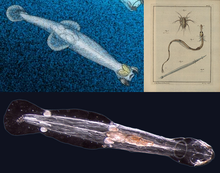
Back Pylwurm Afrikaans ديدان سهمية Arabic ديدان سهميه ARZ Çənəsiqıllılar Azerbaijani Шчацінкасківічныя Byelorussian Четинкочелюстни Bulgarian Chaetognatha BS Quetògnats Catalan Ulod nga gapasan CEB Ploutvenky Czech
| Arrow worms Temporal range:
| |
|---|---|

| |
| Chaetognatha and some examples of their diversity. | |
| Scientific classification | |
| Domain: | Eukaryota |
| Kingdom: | Animalia |
| Clade: | ParaHoxozoa |
| Clade: | Bilateria |
| Clade: | Nephrozoa |
| (unranked): | Protostomia |
| (unranked): | Spiralia |
| Clade: | Gnathifera |
| Clade: | Cucullophora |
| Phylum: | Chaetognatha Leuckart, 1854 |
| Class: | Sagittoidea Claus & Grobben, 1905 [2] |
| Orders | |
The Chaetognatha /kiːˈtɒɡnəθə/ or chaetognaths /ˈkiːtɒɡnæθs/ (meaning bristle-jaws) are a phylum of predatory marine worms that are a major component of plankton worldwide. Commonly known as arrow worms, they are mostly nektonic; however about 20% of the known species are benthic, and can attach to algae and rocks. They are found in all marine waters, from surface tropical waters and shallow tide pools to the deep sea and polar regions. Most chaetognaths are transparent and are torpedo shaped, but some deep-sea species are orange. They range in size from 2 to 120 millimetres (0.1 to 4.7 in).
Chaetognaths were first recorded by the Dutch naturalist Martinus Slabber in 1775.[3] As of 2021, biologists recognize 133 modern species assigned to over 26 genera and eight families.[3] Despite the limited diversity of species, the number of individuals is large.[4]
Arrow worms are strictly related to and possibly belonging to Gnathifera, a clade of protostomes that do not belong to either Ecdysozoa or Lophotrochozoa.
- ^ Vannier J, Steiner M, Renvoisé E, Hu SX, Casanova JP (March 2007). "Early Cambrian origin of modern food webs: evidence from predator arrow worms". Proceedings of the Royal Society B: Biological Sciences. 274 (1610): 627–33. doi:10.1098/rspb.2006.3761. PMC 2197202. PMID 17254986.
- ^ "Sagittoidea Claus and Grobben, 1905". Integrated Taxonomic Information System. Retrieved February 8, 2012.
- ^ a b Cite error: The named reference
Perez2021was invoked but never defined (see the help page). - ^ Bone Q, Kapp H, Pierrot-Bults AC, eds. (1991). The Biology of Chaetognaths. London: Oxford University Press. ISBN 978-0-19-857715-7.